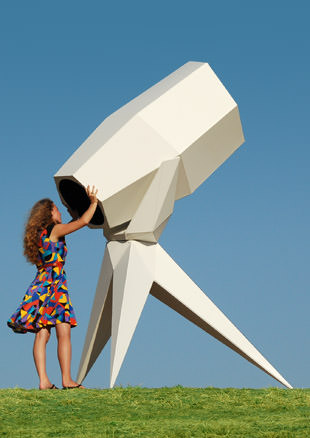[/caption]
What if there were a device that could provide an interactive experience for city dwellers to be able to gaze at the wonders of our night sky, while also providing a beautiful sculpture for landscapes, parks and gardens? Two inventors who specialize in digital interactive design are working on just such a device, and they call it the Humble Telescope. “We like to bring new experiences to people by finding innovative ways to use technologies,” said Steven Mieszelewicz president of a company called ENESS, based in Melbourne, Australia. “I think everyone at some stage in their lives loves to learn about space, but there’s the problem that many people can’t see the night sky without traveling an hour outside the city. We want to help people be able to marvel at the universe around them.”
ENESS is designing the Humble Telescope as an interactive civic sculpture that not only brings the wonders of space down to earth, but also encourages people to learn more about the universe and perhaps appreciate our own world a little more. The telescope works by using 3-D simulation software that incorporates actual images of space from NASA, along with GPS technology. When the user points the telescope in any direction, no matter what location the telescope if located on Earth, the Humble Telescope will show what exists in that area of the sky. It works during the day or night, cloudy or clear.
Watch the video below to see how it might work:
Mieszelewicz and his partner Nimrod Weis design 3D software applications and animations such as interactive maps, as well as creating interactive public art installations and environmental design concepts.
“We’ve been living and breathing interactivity, creating new experiences, and dealing with technology,” said Meiszelewicz, “We love the idea of enhancing active environments and we also feel that artwork should be accessible and relevant to everyone. And we wanted to combine all that to create something to make space and astronomy relevant to everyone.”
They also wanted to do something for the International Year of Astronomy, and hope to have the Humble Telescope ready by October 2009.
Mieszelewicz noted that they came up with the name before they heard about the “Humble Space Telescope,” the small Canadian telescope that was launched into space in 2003. (The official name of the telescope is MOST or Microvariability and Oscillations of STars, but it’s affectionately known as the Humble, a takeoff on the larger Hubble space telescope.) “We liked the name “Humble” because we wanted to do something that makes us more humble and more conscious about what we’re doing to our planet and how small we really are. We saw the name as being a good message for people.”

The company is fairly far along with the design of the interior workings of the telescope. “We have put a considerable amount of time into how everything will be achieved,” said Mieszelewicz. “We already have written software on how to map out the solar system, so it’s not a massive hurdle for us.” But they are also looking at teaming up with a technology institute in Japan who has developed some open source software that will be helpful in the design.
The exterior structure however, is still being considered. “We’re discussing different ideas and the considerations for the design, to make it foolproof in a way, so it’s safe for public use, where people can’t hurt themselves while using it.” Mieszelewicz said. “We wanted it to be a city sculpture because it’s a very positive sort of image, being able to look up at the stars. We like the idea that people can get their hands on it and move its position – but it won’t be able to be wildly swung around, and people will need to take a patient role in using it.” Mieszelewicz said they want to emphasize the observation part rather than that you can swing around on it like a toy.
Mieszelewicz thinks the Humble Telescope will likely look like the promo images seen here, but they are still looking at how people will be able to move it. “We want to give it a very mechanical feel, maybe with a wheel or something that will give it rotation and another wheel will to move the angle,” he said.
Where would you be able to find a Humble Telescope? Mieszelewicz said they are still deciding whether to have the telescopes at permanent locations, or if they would travel city to city, like a traveling exhibition.
They’ve received inquiries about the telescope sculptures from several cities around the world, and also from the Space Telescope Science Institute in Baltimore, home of the Hubble Space Telescope, which might be interested in having one in the gardens on the Institute’s property.
Mieszelewicz said they haven’t yet determined the cost of the telescopes, and costs would be dependent on whether the sculpture was permanent or was a touring model that might stay a a location for 3-12 months before moving to another city. He said they received considerable interest in the touring idea, so that would change the way they would market and price the telescopes.
See ENESS’s website for more information on the company and the Humble Telescope.


What telescope? I can’t see the telescope in that picture…LOL.
This would be a lovely educational tool that could be installed on elementary school, high school, and university grounds. Perhaps leads to monitors inside the school buildings could be provided, so that numerous people could use the instrument at the same time — instead of pointing the physical instrument at a certain place in the sky, you’d “point” the software in that direction from inside a building. This might prevent fights over the instrument’s use among elementary school pupils. At any rate, what a great idea!
They had better have insurance if they do not have a full time guard- around here someone would take it home on the very first night.
That’s a pretty spiffy concept.
I wouldn’t mind having one in my backyard… any chance of a home sized version in the future?
Max- depending on how much room you have at home, you could have one right in your own living room-$40K Cash or credit ! See the Universe, even from the inside of a cave.
too bad the light pollution is worst where this instrument is best placed, but even if the idea is compromised it should still be pursued.
Not nearly that much money, I’m thinking.
If I understand this correctly the instrument doesn’t “see” anything. It simply displays pre-captured images or renders in tune to how the user points it.
Look at your bedroom wall in the right direction and you’ll see Saturn’s moons with Hubble clarity.
An LCD screen, some accelerometers, gps, a few other sensors… not much different to an iPhone.
Granted it wouldn’t sell millions, but get it around $1000 bucks and what school wouldn’t want a few?
More virtuality for the masses…I’d rather see the universe for real than watch something i could get in 30s on google.
The sky is not a mcdonalds, sometimes its nice, sometimes cloudy, sometimes the moon outshines everything and sometimes its amazing. This kind of vulgarization is risky because it makes the sky into just another 2D pixel image, it takes away the magic of real optical observation and may instead of fueling interest just be a 5 minutes VR/wii thing which kids will forget all about the day after.
I can see why they want to do this but it should not be called a telescope, its just a multimedia screen disguised in a really ugly design.
The problem is that the masses (who we count on for support towards big things like hubble) don’t have any access to the sky beyond their laptops.
They won’t be introduced to any of these joys.
We as a species are far too ignorant of space… And I think it’s because when many of us look up, they don’t see anything at all.
Space doesn’t exist to them, and by extension doesn’t exist to our law makers.
This is a worthy project, I’d only wish it could be more widespread.
I thought it was a very cool looking scope, and that it needs to be pointed in the direction of the target object really makes it more informative than looking at a computer screen, because it wil show people what is out there behind the skyglow.
I like the idea of wheels or cranks to move the scope itself, it makes the motion slow and ponderous, and would allow the user to ‘see’ the sky moving through the view. I agree, these things would have to be pretty securely bolted down……. and I also agree that smaller models would be a great hit at schools, summer camps, scout campgrounds, parks, and all manner of outdoor recreation areas. ANYTHING that gets people, especially young people, looking up at the cosmos is a good thing!!!
this is a very good idea. I’d love to see some of these installed around African cities to whip up more interest in Astronomy.
I just have to say this: “Humble Telescope” is sheer genius. 😀
The “image” used for the Andromeda Galaxy (M31) was the rendering for the Milky Way Galaxy released a few years ago that shows our central bar. This rendering is not the latest version–it shows too many arms; a revised version based on Spitzer data shows only two main arms. M31 has no such bar and is a regular spiral. If this demo shows such gross inaccuracy, what will the final product offer? Not an auspicous start.
I’m not a fan of having this device resemble a real telescope. Real telescopes are made to observe the real sky in real-time, with all its unpredictability and infinite possiblities. This device is a variation on the planetarium, not the telescope. Guess what will happen when a child, after looking through this thing, gets a real telescope and discovers that he can’t see the Orion nebula in color? Into the closet will go the telescope and back to the TV screen will go the child. Everyone who enters a planetarium knows that what they see is a simulation of the night sky. This astro-kaleidescope blurs that distinction in its current form. I urge that it be redesigned NOT too resemble a telescope.
Lloyd, I tend to agree. There are many public domain pictures of Andromeda out there, the least they could have done was use a real image. Ditto for Saturn… was the Cassini website down when they put together the demo? =)
They were apparently shooting for a caricature of a real telescope. I doubt anyone would be fooled once they started to tinker with it, even if it looked identical to the real thing.
Four more points I’d like to make tho:
1) Real telescopes are frustrating for novices to use, most guides are unreadable.
2) Much of today’s astronomy is done on laptops instead of mountain tops.
3) The target audience is likely one that doesn’t star gaze, at all.
4) Space doesn’t only come out at night.
As an introductory device I think this is a fantastic idea. Taken a step further, I don’t see why it cant be used for study.
Hubble images on a laptop or in a fancy projector are all the same.